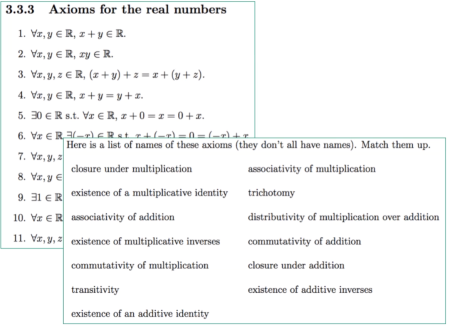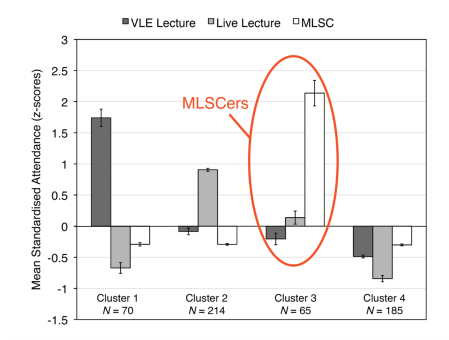Engaging students from diverse backgrounds
Wildon's Weblog 2021-09-17
On 14 September 2021 Royal Holloway Mathematics held a meeting Engaging students from diverse backgrounds, organised by Stefanie Gerke and me, and sponsored by the London Mathematical Society. The speakers were invited to give practical advice on the challenges of teaching university level mathematics. I won’t try to summarise all aspects of the four interesting talks, or all the discussion they stimulated, but here at least is a partial record.
Barrie Cooper
I’ll begin with Barrie Cooper’s talk, since although it came second, it touches on many themes developed more fully in the other three talks. His title was Competencies, challenge, and co-curation: selected strategies for inclusive assessment in mathematics. He started by asking the audience what the terms ‘diversity’ and ‘inclusion’ meant to them: answers included the students’ race, gender and social capital (a useful notation I think: easy to take it for granted when one has it, and easy to assume others have it when they don’t), and the preparedness of our students for academic study. He then discussed strategies for designing inclusive assessments. One key point was that we should make clear what is expected at each level: what do students need to do to pass, to get a 2:1, and to get a first? Not making these expectations clear may particularly hurt students coming from disadvantaged backgrounds.
Barrie pointed out that designing inclusive assessment meant assessing different skills, and assessing in different ways. For example, his course (on graph theory) had only 30% of credit on the final exam, which was open book. Part of the balance was made up of ‘competency based assessment’: basic tests of understanding on which the required pass mark was 100%. Tools such as Stack, Numbas and, more ambitiously, GitHub Classroom were mentioned.
Barrie finished by going into more detail on ‘co-curation’ in the topical context of epidemic modelling on a dynamic network with probabilistic infection. Students used the R-package epimodel, working in small groups to generate results by experimentation with the model, and sharing whatever resources they found most useful — not always those that Barrie had anticipated. It all sounded like a great exercise to me: both mathematically deep, but also bringing in wider concerns, and open-ended in that (as we’ve seen many times in the last 18 months) there’s no unique right answer.
Lara Alcock
Lara Alcock first spoke at Royal Holloway back in 2015. I wrote up this meeting here. For many of us, this was the first time we had heard anyone talk about research in mathematical pedagogy; the event spurred several of us to experiment with new teaching approaches, including the ‘flipped classroom’. Lara’s preferred model was clear from her title: Tilting the classroom: engaging students in large classes. As her abstract promised, she gave 18 (a mathematical 18, there were probably more) straightforward practices to improve student engagement in large lectures. Here are some that stood out for me.
- Put administrative announcements on the board / projector as students come in.
- Start with simple multiple choice questions that test students on material they are supposed to have prepared. I think something like this is essential: students won’t bother preparing unless they know we are serious about it, and this means investing time in live-sessions.
- Give students `gappy’ notes or other activities that they complete during the lecture or during pauses in online videos. For instance, the matching exercise shown below, which seems a nice way to demystify the dry-as-dust field axioms.
- Give students guidance on how to study: Lara mentioned a study of Bjork et al showing there are powerful misconceptions on this issue: one conclusion (see after Figure 3) is that learners typically underestimate the improvement they can make due to studying, but also underestimate the amount they will forget without periodic reinforcement.
- Self-explanation training: how to think deeply about a proof in a way that goes beyond paraphrasing it.
- Ask questions that may split the audience, for instance, which of
,
,
is correct in this gap? `Whatever you think, half the people disagree with you … do you want to change your mind?’.
- Read and explain a proof to the person next to you (viable even with social distancing).

The context was a first year analysis course, a subject that is a notorious source of student complaints and disengagement. It was clear from Lara’s talk and the comments from students she cited that her approach worked, and that students rose to the challenge of her course, both when delivered using live large lectures and, post-Covid, with online lectures. Lara’s enthusiasm for the large lecture as an effective way to teach students shone through: she ended by remarking `I’d much rather have large lectures back: I miss the atmosphere’. For more on of Lara’s approach to analysis teaching, I highly recommend her book, How to think about analysis.
Matthew Inglis
Matthew’s title was Individual differences in students’ use of optional learning resources and concerned two cohorts of students: one doing a mathematics degree, the other studying mathematics as part of an engineering degree. The resources available to them were
- Traditional live lectures
- Mathematics Learning Support Centre (like a continuous workshop with a staff member always on call)
- Online video lectures and other E-resources
Usage was tracked throughout the term. It was quickly clear that there were four distinct clusters: the `traditionalists’ who attended live lectures, the `MLSCers’ who made high use of the support centre, the `E-learners’, and (his term) the `slackers’, who did not make much use of anything.
 As his graph above shows, the clusters were very pronounced: despite all our efforts with `active blended learning’, it seems students stuck with one learning mode throughout their course. Matthew presented extensive data showing that the traditionalists and MLSCers did best at the exam, the E-learners did significantly worse, and the slackers did very badly indeed. The most significant correlation across all clusters for attainment was with live-lecture attendance, even after normalising the data to take into account the different courses.
As his graph above shows, the clusters were very pronounced: despite all our efforts with `active blended learning’, it seems students stuck with one learning mode throughout their course. Matthew presented extensive data showing that the traditionalists and MLSCers did best at the exam, the E-learners did significantly worse, and the slackers did very badly indeed. The most significant correlation across all clusters for attainment was with live-lecture attendance, even after normalising the data to take into account the different courses.
Matthew ended by speculating on what would happen if the online lectures were withdrawn? Would the E-learners simply become slackers? Or would they move into another cluster? Since the E-learners did less well than the other two clusters, is producing online videos a good investment of our time? When I lectured cryptography last year, I put a vast effort into making short online videos: even without editing (but some re-recording) I think this took me far longer than delivering the lectures. They were very popular with the students, and attainment was good, but I certainly can’t give an unqualified `yes’ in answer to Matthew’s question. As he said, offering students too much choice makes work for their lecturers.
Maurice Chiodo
After a break for lunch we finished with Maurice’s talk Societal responsibility and ethical conduct in mathematics. He started by challenging the idea that pure mathematics is a universal force for good, or, at worst, morally neutral. Instead, like any powerful took, it can be used for good or harm, and the harm may arise inadvertently.
A compelling example of this is the use of machine learning algorithms in predictive policing: concentrating police in one area may well find more crime, but at the expense of leaving other crime undetected, and creating a feedback loop that damages community relations. Other examples included the epidemic modelling from Barrie Cooper’s talk, the A-level results fiasco in September 2020, and what we know from the Snowden leaks about mass internet surveillance.
A recurring theme was that models based on unsound implicit assumption could be mathematically sound, but lead to the wrong conclusions. For instance, he mentioned that the modelling of the spread of Covid-19 in care homes failed to consider that many staff (often employed by agencies) moved between care homes. Another instance comes from finance: given independent risky assets each with a normal
return, their mean has variance
, so mathematically is a safer investment. (This is the infamous Collatoralized Debt Obligation, peddled enthusiastically by investment banks such as Goldman Sachs who rewarded their clients by then betting against the asset they had just purchased.) As the 2008 Financial Crisis showed, the independence assumption is utter garbage. Yet another worrying example comes from the use of Machine Learning in sentencing algorithms: the algorithm faithfully learns to perpetuate past racial biases.
Maurice then made the key point that students `fail to hear us say that there are ethical issues’. If they are important (and they are), why don’t we tell them? Successfully introducing ethics into the mathematics curriculum has three requirements:
- A seminar series or lecture series or course on societal responsibility in mathematics;
- Mathematical exercises with an ethical component;
- Students must see that all their lecturers take ethics seriously.
As a step towards this, next time I lecture a cryptography course I will set explicit questions on the ethnical issues, rather than just leave them to asides in lectures or printed notes. I hope Maurice’s talk will encourage others to make similar changes: this seems to be to be a valuable way we can broaden our curriculum and maybe even increase student engagement.
Maurice made many further interesting points. For instance, mathematics students appear to gravitate to a utilitarian perspective on ethics; he mentioned the Trolley Problem as a way to counter this. (Even before the Fat Man makes his appearance one can challenge strictly utilitarian `body-count’ ethics by making the person on the second track a close relative, rather than the typical stranger.) He finished by saying that `He was far more scared of 10 mathematicians than 10 lawyers … so why is it that the lawyers get ethical training but we don’t?’
Conclusion
We were lucky to get four interesting talks by excellent speakers. We had postponed the meeting from May 2020 in the hope of holding it face-to-face, but still, the online format enabled a broader attendance from people around the UK.
All four talks had practical advice, but also surprises to offer: how many of us would have predicted the four sharp clusters in Matthew Inglis’ talk (well perhaps, the existence of the ‘slacker’ cluster was no surprise), or the enthusiasm for live lectures shown by Lara’s students.
The final discussion session also offered much to think about: for instance, my not-so-secret view is that university education by intelligent, well-read, liberally minded people has a civilizing influence and value that goes beyond the subject specific skills and knowledge we hope to impart; but this view can rightly be challenged as patronising to our students. Barrie’s talk in particular made me realise that ‘decolonizing the curriculum’ isn’t just the buzz-phrase de jour: there are real practical changes we should all be making to ensure that the mathematics we love so much remains accessible to our changing student intake.
Comments are very welcome and can be posted below.